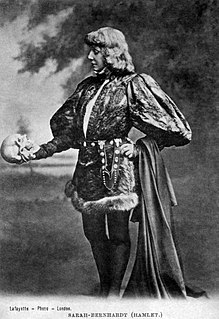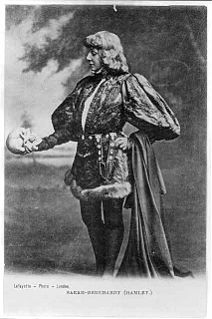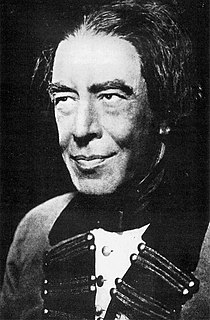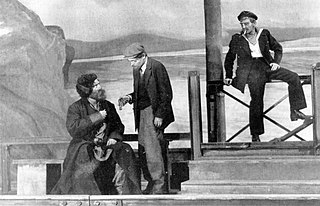Chronology of production
The story of Craig and Stanislavski began in 1908 when the eccentric American dancer Isadora Duncan, who had a daughter with Craig, introduced the two to each other. Craig, an English theatre practitioner, had garnered interest for the symbolist and simplistic designs he brought to plays like Henrik Ibsen’s The Vikings at Helgeland. On the other end of the spectrum Constantin Stanislavski was creating a world of theatre based upon realism, the internal complexities of the mind, and the rise of psychology. As Benedetti stated, “Stanislavski hoped to use the production to prove that his recently developed 'system' for creating internally justified, realistic acting could meet the formal demands of a classic play”. [4] In response to the enthusiasm expressed by Isadora Duncan about Craig's work, Stanislavski encouraged the board of the MAT to invite Craig to Moscow. [5] He arrived in October 1908. [6]
The board decided in January 1909 to mount the production during its 1910 season, with work on the project to commence immediately.
Rehearsals began in March 1909. In April, Craig returned to Russia, meeting with Stanislavski in St Petersburg, where the company was on tour. [7] Together they analysed the play scene-by-scene, then line-by-line, and devised a meticulous production plan, which included sound, lighting, and an outline of the blocking. Since neither understood the other's language, they conducted their discussions in a mixture of English and German. This paired with the fact that Craig spent little time at rehearsal with the actors, caused the cast to say Craig was extremely difficult to work with. Craig spent more of his time with a built-to-scale replica of the set, where he used woodcuts of the actors to devise blocking. Craig was also highly demanding with Alisa Koonen, who played Ophelia, saying on his directions, “no actress could do it” (Innes 159). This had much to do with his wish of the actor to be an Ubermarionette; that is, an actor who allowed the director complete and total control. They relocated to Moscow in May and worked together until the beginning of June, when Stanislavski left for Paris. [8]
In February 1910, Craig returned to Moscow. In the intervening period, Stanislavski had developed an important production of Turgenev's A Month in the Country , whose success had demonstrated the value of his new 'systematic' approach to the actor's work; he was keen to assay its virtues in the crucible of Shakespeare's tragedy. [9] They planned to rehearse the company together until April, after which Stanislavski would rehearse alone until the summer. In August, Craig would return once more and the production would open in November 1910.
As it was, Stanislavski was diagnosed with typhoid fever in August and the production was postponed until the next season; Stanislavski was unable to return to rehearsals until April 1911. [10] The play finally opened on 5 January 1912 [ O.S. 23 December 1911]. [11]
Aesthetic approaches
The day we see Hamlet die in the theatre, something of him dies for us. He is dethroned by the spectre of an actor, and we shall never be able to keep the usurper out of our dreams.
Maurice Maeterlinck (1890). [13]
When Stanislavski extended his invitation to Craig in April 1908, he was completely overcome by his eagerness to work with progressive theatre artists. However, Stanislavski was unaware of how vastly different his vision for the future was from Craig's. Following his failed experiment with Meyerhold and the studio, Stanislavski began to emphasize the importance of the actor. He believed that “neither the set, nor the director, nor the designer can carry the play…it is in the hands of the actor”. [14] It was this principle that drove him to significantly reconsider the approach of the actor. By the time Stanislavski became aware of Craig, he was beginning to develop the concepts that would later serve as the backbone for his “system”. He was determined that good acting came from internal motivations rather than outward shows. While Stanislavski's ideas centered almost entirely on the role of the actor, Craig's vision of a new theatre minimized the actors’ importance to that of an instrument through which the director's vision is brought to life. “The actor must no longer express himself, but something else; he must no longer imitate, but indicate”. [15] In Craig's opinion good theatre required a unity of all elements under the control of one person.
In line with a tendency within the Symbolist movement to view Shakespeare's play as a work of poetry rather than as one for the stage, Craig wrote in his influential manifesto The Art of the Theatre (1905) that it "has not the nature of a stage representation." [16] The playwright Maurice Maeterlinck (whom Stanislavski visited in the summer of 1908 to discuss his forthcoming production of The Blue Bird ) had argued 15 years earlier that many of the greatest dramas in the history of theatre, including Hamlet, were "not stageable." [17] In 1908, Craig again insisted that an adequate staging of the play was "impossible." [18] When he suggested the play to the MAT, he wanted "to test my theory that the Shakespearean play does not naturally belong to the art of the theatre." [19]
Craig conceived of the production as a symbolist monodrama in which every aspect of production would be subjugated to the play's protagonist: the play would present a dream-like vision as seen through Hamlet's eyes. To support this interpretation, Craig wanted to add archetypal, symbolic figures—such as Madness, Murder, and Death—and to have Hamlet present on-stage during every scene, silently observing those in which he did not participate. Stanislavski overruled him. [20] Stanislavski wished the actors to accompany the text with raw palpable emotion, of course, never straying far away from his system. Meanwhile, Craig sought for the actors to not try and make their characters emotional state present. This did not mean he wanted a dead show but on the contrary he believed the text clearly stated each character's motives and feelings. He strove for simplicity that Kaoru Osanai, in the Educational Theatre Journal, calls “simplicity in expression not in content.” So in some scenes where Stanislavski wanted many actions to take place Craig wished for little to no movement to let the poetry take the lead.
Despite this apparent opposition between Craig's symbolist aesthetic and Stanislavski's psychological realism, however, the two did share some artistic assumptions; the 'system' had developed out of Stanislavski's experiments with symbolist drama, which had shifted the emphasis of his approach from a naturalistic external surface to the inner world of the character's "spirit". [21] Both had stressed the importance of achieving a unity of all theatrical elements in their work. [22] In a letter written in February 1909 to Liubov Gurevich about his recent production of Gogol's The Government Inspector , Stanislavski confirmed his "return to realism" but expressed the belief that this would not hinder the collaboration:
Of course, we have returned to realism, to a deeper, more refined and more psychological realism. Let us get a little stronger in it and we shall once more continue on our quest. That is why we have invited Gordon Craig. After wandering about in search of new ways, we shall again return to realism for more strength. I do not doubt that every abstraction on the stage, such as impressionism, for instance, could be attained by way of a more refined and deeper realism. All other ways are false and dead. [23]
Craig's and Stanislavski's interpretations of the central role of Shakespeare's play, however, were quite different. Stanislavski's vision of Hamlet was as an active, energetic and crusading character, whereas Craig saw him as a representation of a spiritual principle, caught in a mutually destructive struggle with the principle of matter as embodied in all that surrounded him. Hamlet's tragedy, Craig felt, was that he talks rather than acts. [24]
Visual design
The most famous aspect of the production is Craig's use of a single, plain set that varied from scene to scene by means of large, abstract screens that altered the size and shape of the acting area. [25] There is a persistent theatrical myth that these screens were impractical and fell over during the first performance. This myth may be traced to a passage in Stanislavski's My Life in Art (1924); Craig demanded that Stanislavski delete the story and Stanislavski admitted that the incident occurred only during a rehearsal. He eventually provided Craig with a sworn statement that the mishap was due to an error by the stage-hands and not the design of Craig's screens. The screens had been built ten feet taller than Craig's designs specified, which may have also contributed to the mishap. Craig had envisaged specially costumed, visible stage-hands to move the screens, but Stanislavski had rejected the idea. This forced a curtain close and delay between scenes, which disrupted the sense of fluidity and movement inherent to Craig's conception. [26] The different arrangements of the screens for each scene were used to provide a spatial representation of Hamlet's state of mind or to underline a dramaturgical progression across a sequence of scenes, as visual elements were retained or transformed. [27] In terms of costume design there were also differences between the two artists. For example, in the scene containing the dumb show Craig wished for the Actors to wear oversized masks, but Stanislavski despised this idea as it did not ring true to a realistic style of acting. Eventually there was a compromise which allowed the actors to wear makeup along with extravagant beards and wigs (Innes 158).
The kernel of Craig's monodramatic interpretation lay in the staging of the first court scene (1.2). [28] The stage was divided sharply into two areas through the use of lighting: the background was brightly lit, while the foreground was dark and shadowy. The screens were lined up along the back wall and bathed in diffuse yellow light. From a high throne upon which Claudius and Gertrude sat, which was bathed in a diagonal, bright golden beam, a pyramid descended, representing the feudal hierarchy. The pyramid gave the illusion of a single, unified golden mass, from which the courtier's heads appeared to stick out through slits in the material. In the foreground in dark shadow, Hamlet lay slouched, as if dreaming. A gauze was hung between Hamlet and the court, further emphasising the division. On Claudius' exit-line the figures remained in place while the gauze was loosened, so that the entire court appeared to melt away before the audience's eyes, as if they had been a projection of Hamlet's thoughts that now had turned elsewhere. The scene, and the gauze effect in particular, prompted an ovation from the audience, which was unheard of at the MAT. [28]

Acting is an activity in which a story is told by means of its enactment by an actor or actress who adopts a character—in theatre, television, film, radio, or any other medium that makes use of the mimetic mode.

The Tragedy of Hamlet, Prince of Denmark, often shortened to Hamlet, is a tragedy written by William Shakespeare sometime between 1599 and 1601. It is Shakespeare's longest play, with 29,551 words. Set in Denmark, the play depicts Prince Hamlet and his revenge against his uncle, Claudius, who has murdered Hamlet's father in order to seize his throne and marry Hamlet's mother.

Konstantin Sergeyevich Stanislavski was a seminal Soviet and Russian theatre practitioner. He was widely recognized as an outstanding character actor and the many productions that he directed garnered him a reputation as one of the leading theatre directors of his generation. His principal fame and influence, however, rests on his 'system' of actor training, preparation, and rehearsal technique.

Edward Henry Gordon Craig, sometimes known as Gordon Craig, was an English modernist theatre practitioner; he worked as an actor, director and scenic designer, as well as developing an influential body of theoretical writings. Craig was the son of actress Dame Ellen Terry.

The Seagull is a play by Russian dramatist Anton Chekhov, written in 1895 and first produced in 1896. The Seagull is generally considered to be the first of his four major plays. It dramatises the romantic and artistic conflicts between four characters: the famous middlebrow story writer Boris Trigorin, the ingenue Nina, the fading actress Irina Arkadina, and her son the symbolist playwright Konstantin Treplev.

The Power of Darkness is a five-act drama by Leo Tolstoy. Written in 1886, the play's production was forbidden in Russia until 1902, mainly through the influence of Konstantin Pobedonostsev. In spite of the ban, the play was unofficially produced and read numerous times.

Epic theatre is a theatrical movement arising in the early to mid-20th century from the theories and practice of a number of theatre practitioners who responded to the political climate of the time through the creation of new political dramas. Epic theatre is not meant to refer to the scale or the scope of the work, but rather to the form that it takes. Epic theatre emphasizes the audience's perspective and reaction to the piece through a variety of techniques that deliberately cause them to individually engage in a different way. The purpose of epic theatre is not to encourage an audience to suspend their disbelief, but rather to force them to see their world as it is.

Stanislavski's system is a systematic approach to training actors that the Russian theatre practitioner Konstantin Stanislavski developed in the first half of the twentieth century. His system cultivates what he calls the "art of experiencing". It mobilises the actor's conscious thought and will in order to activate other, less-controllable psychological processes—such as emotional experience and subconscious behaviour—sympathetically and indirectly. In rehearsal, the actor searches for inner motives to justify action and the definition of what the character seeks to achieve at any given moment.

The Moscow Art Theatre was a theatre company in Moscow. It was founded in 1898 by the seminal Russian theatre practitioner Konstantin Stanislavski, together with the playwright and director Vladimir Nemirovich-Danchenko. It was conceived as a venue for naturalistic theatre, in contrast to the melodramas that were Russia's dominant form of theatre at the time. The theatre, the first to regularly put on shows implementing Stanislavski's system, proved hugely influential in the acting world and in the development of modern American theatre and drama.
Twentieth-century theatre describes a period of great change within the theatrical culture of the 20th century, mainly in Europe and North America. There was a widespread challenge to long-established rules surrounding theatrical representation; resulting in the development of many new forms of theatre, including modernism, expressionism, impressionism, political theatre and other forms of Experimental theatre, as well as the continuing development of already established theatrical forms like naturalism and realism.
My Life in Art is the autobiography of the Russian actor and theatre director Konstantin Stanislavski. It was first commissioned while Stanislavski was in the United States on tour with the Moscow Art Theatre, and was first published in Boston, Massachusetts in English in 1924. It was later revised and published in a Russian-language edition in Moscow under the title Моя жизнь в искусстве. It is divided into 4 sections entitled: 1-Artistic Childhood, 2-Artistic Youth, 3-Artistic Adolescence and 4-Artistic Adulthood.

Realism in the theatre was a general movement that began in 19th-century theatre, around the 1870s, and remained present through much of the 20th century. It developed a set of dramatic and theatrical conventions with the aim of bringing a greater fidelity of real life to texts and performances. These conventions occur in the text, design, performance style, and narrative structure. They include recreating on stage a facsimile of real life except missing a fourth wall. Characters speak in naturalistic, authentic dialogue without verse or poetic stylings, and acting is meant to emulate human behaviour in real life. Narratives typically are psychologically driven, and include day-to-day, ordinary scenarios. Narrative action moves forward in time, and supernatural presences do not occur. Sound and music are diegetic only. Part of a broader artistic movement, it includes Naturalism and Socialist realism.

Hamlet by William Shakespeare has been performed many times since the beginning of the 17th century.

The Moscow Art Theatre production of The Seagull in 1898, directed by Konstantin Stanislavski and Vladimir Nemirovich-Danchenko, was a crucial milestone for the fledgling theatre company that has been described as "one of the greatest events in the history of Russian theatre and one of the greatest new developments in the history of world drama." It was the first production in Moscow of Anton Chekhov's 1896 play The Seagull, though it had been performed with only moderate success in St. Petersburg two years earlier. Nemirovich, who was a friend of Chekhov's, overcame the writer's refusal to allow the play to appear in Moscow after its earlier lacklustre reception and convinced Stanislavski to direct the play for their innovative and newly founded Moscow Art Theatre (MAT). The production opened on 29 December [O.S. 17 December] 1898. The MAT's success was due to the fidelity of its delicate representation of everyday life, its intimate, ensemble playing, and the resonance of its mood of despondent uncertainty with the psychological disposition of the Russian intelligentsia of the time. To commemorate this historic production, which gave the MAT its sense of identity, the company to this day bears the seagull as its emblem.

The Mistress of the Inn, also translated as The Innkeeper Woman or Mirandolina, is a 1753 three-act comedy by the Italian playwright Carlo Goldoni about a coquette. The play has been regarded as his masterpiece. Frederick Davies describes it as Goldoni's Much Ado About Nothing.

Armoured Train 14–69 is a 1927 Soviet play by Vsevolod Ivanov. Based on his 1922 novel of the same name, it was the first play that he wrote and remains his most important. In creating his adaptation, Ivanov transformed the passive protagonist of his novel into an active exponent of proletarian ideals; the play charts his journey from political indifference to Bolshevik heroism. Set in Eastern Siberia during the Civil War, it dramatises the capture of ammunition from a counter-revolutionary armoured train by a group of partisans led by a peasant farmer, Nikolai Vershinin. It is a four-act play in eight scenes that features almost 50 characters; crowd scenes form a prominent part of its episodic dramatic structure. Near the end of the play a Chinese revolutionary, Hsing Ping-wu, lies down on the railway tracks to force the armoured train to stop.

Enough Stupidity in Every Wise Man is a five-act comedy by Aleksandr Ostrovsky. The play offers a satirical treatment of bigotry and charts the rise of a double-dealer who manipulates other people's vanities. It is Ostrovsky's best-known comedy in the West.

Liubov Yakovlevna Gurevich was a Russian editor, translator, author, and critic. She has been described as "Russia's most important woman literary journalist." From 1894 to 1917 she was the publisher and chief editor of the monthly journal The Northern Herald, a leading Russian symbolist publication based in Saint Petersburg. The journal acted as a rallying-point for the Symbolists Dmitry Merezhkovsky, Zinaida Gippius, Fyodor Sologub, Nikolai Minsky, and Akim Volynsky. In 1905 she joined the Moscow Art Theatre (MAT) as a literary advisor. She worked as an advisor and editor for the seminal Russian theatre practitioner Konstantin Stanislavski for the next 30 years and influenced his writing more than anyone else. Gurevich and Stanislavski had been writing to one another since the MAT's first tour to St Petersburg and became close friends.

Vasily Ivanovich Kachalov, was one of Russia's most renowned actors. He worked closely and often with Konstantin Stanislavski. He led the so-called Kachalov Group within the Moscow Art Theatre. It was Kachalov who played Hamlet in the Symbolist production of 1911.





















